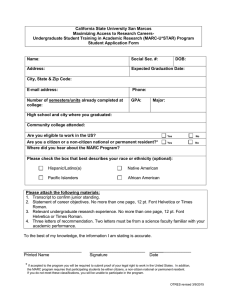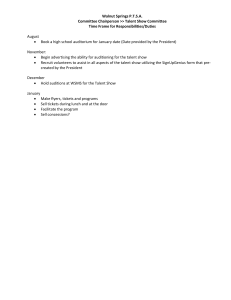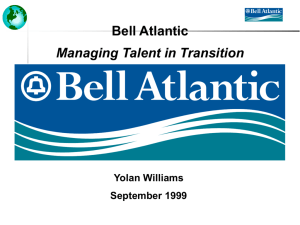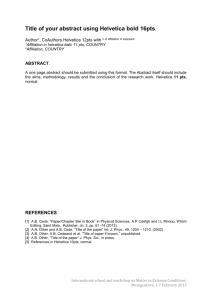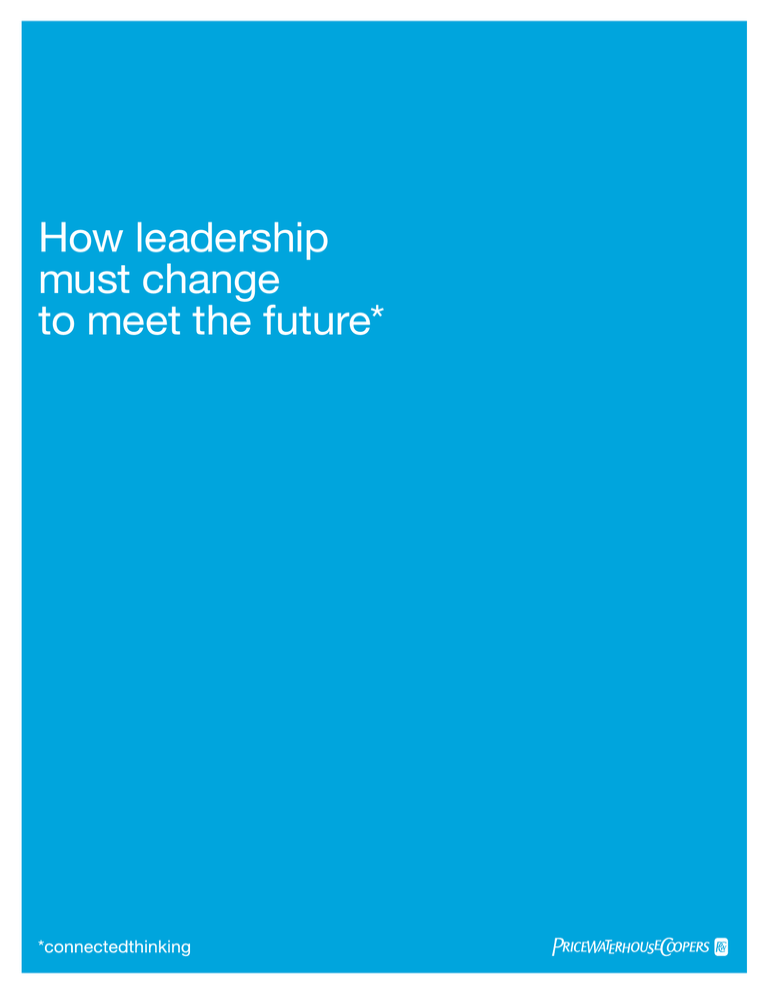
How leadership
must change
to meet the future*
Table of contents
Situation p. 2
Globalization is rapidly redefining today’s business environment.
Significant strategic shifts are transforming the playing field. Vast
opportunities for growth are emerging at the same time that the pool
of high-performing talent capable of seizing those opportunities is
shrinking. Those who can stay ahead of the rapid pace of change,
anticipate talent needs, and take the lead in developing innovative
strategies for the future will likely be tomorrow’s winners.
Our perspective p. 6
Successful business leaders must shape their organizations to be more
nimble and flexible, less hierarchical, and more networked—in short,
better organized to deliver value. The focus should be on key emerging
business revolutions: agility, authenticity, talent, and sustainability. A
distinctive leadership framework—one that defines success quotients—
provides direction on what it will take to lead and shape organizations
in the future.
Implications p. 22
The fate of future business rests, in part, on how well business leaders
can anticipate change, demonstrate authentic leadership, maximize the
power of their talent, and embrace social responsibility.
March 2008
Situation
Leaders will need to
demonstrate a different
set of behaviors.
2
Today’s leaders are already facing challenges and changes that are
rapidly transforming where, how, and with whom they do business.
Leaders who are adapting their strategies are merely keeping pace
with change. A more strategic view of agility is about leaders
anticipating trends and proactively defining innovative strategies.
To anticipate and seize opportunities to drive business success, leaders
will need to demonstrate a different set of behaviors. Organizations need
to start now to build a strong leadership pipeline that demonstrates the
right competencies. Because of the shrinking talent pool, organizations
must build their own leadership pipeline from within.
Situation
Four key revolutions: Business leaders improve the way they do
business through agility, authenticity, talent, and sustainability
Agility is emerging as an essential competency for leaders. The speed
of change will require organizations to be more nimble and flexible.
Those who have the foresight to spot change on the horizon, anticipate
what comes next, and take the lead in developing future strategies to
address evolving market demands will make it to the winner’s circle.
Authenticity is a vital leadership competency in a changing business
environment. Leaders need to create clarity—articulating a vision and
painting a picture of the future. With so many changing variables, they
must lead with confidence and have the courage to take a stand. To
build trust and confidence with their teams, they need to be genuine
in their communications. With change creating anxiety and confusion,
leaders must bring a level of certainty about the path forward and foster
a sense of purpose for their teams.
In 2004, 58.1% of management
positions were filled internally. In
2006 that figure dropped to 50.0%.1
1 PricewaterhouseCoopers/Saratoga, 2007/2008 US Human Capital Effectiveness Report (2007).
Talent is about a leader’s ability to leverage and maximize the impact
of his or her people. To harness the power of their people assets, leaders
must be committed to building a supportive culture and effective
organizational structures and people processes. Organizations that
have not proactively developed talent—who lack the right people
skilled in the right areas, when and where they’re likely to be needed—
are more vulnerable to rapid change. Leaders need to attentively
develop, engage, and motivate people. They must be mindful about
embedding day-to-day coaching and mentoring into the culture.
Sustainability is about demonstrating social responsibility by balancing
business results with concern for the greater good. Although much
attention is being paid to how companies deal with environmental
issues, social responsibility extends beyond just this one area. Focusing
on sustainability means looking beyond short-term results to consider
the longer-term implications of decisions as they relate not just to the
environment, but also to health, safety, and other such areas of concern.
It means taking actions that go beyond regulations to build controls
into the business environment—embedding social responsibility into
business processes and procedures and taking responsibility for the
impact decisions might have on the workforce. Sustainability will be a
major differentiator for a leader’s success in the future. Ultimately, it
may contribute to the long-term survival of an organization and serve
to reshape the business climate.
Top executives agree on success factors
According to our research, top executives believe that these four
revolutions are very important to future success. To bear this out, we
have included throughout this document quotes from CEOs who
responded to PricewaterhouseCoopers’ 10th Annual Global CEO Survey,
as well as information obtained from the PricewaterhouseCoopers/
Saratoga 2007/2008 US Human Capital Effectiveness Report.
Situation
Our perspective
Business leaders must
shape their organizations
to better deliver value.
Successful business leaders must shape their organizations to be more
nimble and flexible, less hierarchical, and more networked—in short, better
organized to deliver value. The focus should be on four key emerging
business revolutions: agility, authenticity, talent, and sustainability.
In this section we will address what leaders need to know about each of
these revolutions and how they can be translated into success quotients
to define a distinctive leadership framework—one that provides direction
on what it will take to lead and shape organizations in the future.
Our perspective
Figure 1
Talent can be an
organization’s greatest asset
or liability. The good news is
that whether it is the former
or the latter, it is entirely
within management’s control.
Business
impact
Strategic
alignment
with business
priorities
Activity-based
approach
Anticipatory
Adaptive
Reactive
Approach to managing talent
Footer
The agility revolution
According to “Revolutions in Our Midst: Three Ways Our World Is Being
Remade,” an article that appeared in the September 2007 issue of the
PricewaterhouseCoopers publication View, agility is a core competence
for organizations operating in today’s high-speed and increasingly global
business environment.
To maximize business impact in today’s increasingly competitive
marketplace and drive future success, business leaders must position
their organizations to be more nimble and flexible—poised to anticipate
and drive change.
“Innovation and empowerment
are keys to flexibility.”
Respondent, PricewaterhouseCoopers’
10th Annual Global CEO Survey
10
An anticipatory workforce—one that thrives on innovation—will be an
essential determinant of future success. To build such a workforce,
leaders must themselves demonstrate agility and embed it into the way
work is done throughout the organization. That means encouraging and
appropriately rewarding innovation so that individuals are willing to test
the status quo and take the risks that go hand in hand with defining
new products and services. Respondents to our CEO survey stressed
the importance of innovation in helping them shape the future of their
organizations and adapt more effectively to the rapid pace of change.
Standardizing processes also contributes to an agile environment.
For example, in today’s dynamic environment, decisions must be
made quickly. Therefore, it is critical that leaders demonstrate agility
by empowering others to make decisions rather than limiting decision
making to a select few at the top. To further expedite the process,
decisions should be based on guiding principles rather than on a fixed
set of rules.
Agility is a key factor in attracting the best talent and establishing
a stronger employee value proposition. Those organizations that
encourage and reward innovation and reinforce flexibility will enjoy
a competitive edge in the quest for high-potential talent.
Our perspective
11
“We’ve created a corporate
environment based on
encouraging employee initiative,
delegation of authority, and
strong career development.
These factors motivate.”
Respondent, PricewaterhouseCoopers’
10th Annual Global CEO Survey
12
The authenticity revolution
Being able to mobilize talent around business objectives is more critical
these days than ever before. If leaders are to define and execute their
business agenda in today’s ever-changing environment, it is imperative
that they be realistic about what it takes to make change happen, and
have the courage to take a stand. Those who have the ability to articulate
a vision and communicate with impact and empathy can help to create
optimism, clarity, and certainty in uncertain times. As the business
environment becomes increasingly global, cross-cultural, and networked,
leaders will need to find ways to inspire their teams using creative
and collaborative methods. Fostering collaboration in a cross-cultural
environment will put leaders to the test, honing their ability to actively
listen, to empathize, and to nurture innovation. The bottom line: A truly
authentic leader relates well to others, is open to new ideas, and can
inspire high levels of performance in tough times.
Our perspective
13
The talent revolution
The competitive quest for high-potential talent is redefining how
organizations look at their people assets and, in particular, how
they can best harness the power of that talent to pursue growth
opportunities. According to one of the executives in our 2007 CEO
survey, “Maximizing talent—attracting, retaining, developing, and
promoting outstanding talent—is one of the critical capabilities that
will distinguish a successful organization now and in the future.”
Leaders must keep their eyes on the horizon to anticipate potential
change and ensure that they have the right talent with the right skill
sets in place when and where it is likely to be needed. Winning the
“war for talent” today will determine whether an organization will be
positioned to win in the dynamic business environment of tomorrow.
To attract and acquire the right talent, organizations will have to translate
new market demands into skill requirements. As the talent playing field
gets more and more competitive, it will become ever more difficult for
companies to attract and retain the high-potential people they’ll need
in order to win going forward. Rather than focusing only on tangibles
like compensation and benefits in choosing where they want to work,
today’s candidates are also taking a close look at intangibles such as
flexibility in the workplace, development opportunities, greater autonomy,
and an appreciation for diversity.
14
Given the rapid pace of change, it is no longer feasible for employees
to learn by trial and error. A shorter time to competence is necessary,
and leaders must explore new ways to share knowledge and embed
learning into work. That means shifting investment dollars to build the
infrastructure for knowledge management. Additionally, with increasing
numbers of baby boomers exiting the workforce and further shrinking
the talent pool, it will be essential to have mechanisms in place to
transfer legacy knowledge going forward.
Moving talent to the top of the business agenda is critical to the survival
of the organization. The turnover rate for high-performing employees
increased by more than 7% in 2006—rising to 5.7%.2 Leaders must
become actively involved in harnessing and maximizing the power
of their people to build competitive strength that will differentiate the
organization in the marketplace of the future. That not only means
going beyond defining career paths and development opportunities,
but also taking an active mentoring role.
Organizations invest an average of
$513 on learning and development
per employee.3
2 Ibid.
3 Ibid.
Our perspective
15
The sustainability revolution
Recognizing that it will take more than just short-term results to
drive future success, savvy leaders are striving to foster a business
climate that balances bottom-line results with the public good, and
to establish business practices focused on social as well as personal
responsibility. For example, both consumers and employees are
demanding a greater focus on green issues and taking active steps
to help ensure environmental sustainability.
To minimize risk, and to do the right thing, top executives should
demonstrate responsible leadership by assessing anticipated
change in order to determine its potential impact on products,
services, and investments.
The quest for sustainability provides an opportunity for companies
to step up and take a leadership role in defining a new business
climate and new strategies to drive a sustainable future. Since core
responsibility is tied closely to the way an organization manages its
people, the winners of tomorrow will weave sustainability into talent
management today—enhancing how their organization attracts,
acquires, develops, deploys, and rewards valued employees.
Research shows that sustainability is a key concern when candidates
are deciding where they want to work, and that it’s also one of the
issues employees consider when deciding whether to remain with
a company or move on. According to a recent study conducted by
PricewaterhouseCoopers, 90% of US respondents said they would
actively seek out employers whose corporate responsibility behavior
reflects their own.4
4 PricewaterhouseCoopers, Managing Tomorrow’s People: The Future of Work to 2020 (2007).
16
Model future leadership behaviors on changing strategies
To succeed going forward, business leaders must go beyond anticipating
trends on the horizon to actually model what success will look like in the
workplace of the future. Doing that effectively requires a new leadership
framework based on agility, authenticity, talent, and sustainability. These
four revolutions are translated into four leadership success quotients,
each of which embodies a set of clearly defined behaviors:
1. The agility quotient
2. The authenticity quotient
3. The talent quotient
4. The sustainability quotient
“I would like to leave behind a
sustainable, workforce-centered
culture.”
Respondent, PricewaterhouseCoopers’
10th Annual Global CEO Survey
Our perspective
17
A distinctive leadership framework is vital
A distinctive leadership framework will help organizations clarify what
successful leadership looks like, build leadership capability for the future,
and redefine measures of success. Leadership success quotients help
to define the attributes that differentiate high-performance leadership.
While the quotients may not encompass all possibilities, trends strongly
suggest the need for a new set of leadership behaviors.
The agility quotient: To demonstrate agility and personal resiliency in
the way they anticipate, adapt to, and lead change, successful leaders
must create a culture conducive to change, one that encourages people
to stretch their imaginations and innovate by rewarding forward thinking
and risk taking.
The authenticity quotient: To mobilize the global workforce amid
constant change, successful leaders must articulate a vision of how
to be competitive in a complex work environment, then communicate
that vision with impact, empathy, and optimism. It is important to
demonstrate personal courage by taking a stand on critical issues
regardless of what is popular.
18
The talent quotient: To harness and maximize the power of talent,
successful leaders must drive connectivity by building alliances within
and across organizations. To demonstrate a commitment to building
talent capability, they should be actively involved in the development,
succession, and mentorship of their people. Given the demographic and
generational shifts we are witnessing, leaders should demonstrate and be
role models for openness to different perspectives, ideas, and styles.
The sustainability quotient: To demonstrate their ability to create a new
business climate that embeds a global mindset into decision making and
the way they operate the business, successful leaders must balance their
focus, working for bottom-line results while also focusing on the public
good. Furthermore, they must take greater responsibility for the welfare
of their employees.
Our perspective
19
Section Title
A
distinctive
Statement is set at
leadership
36/36, Helvetica
framework
Roman, in light color,
4 lines maximum.
Figure 2
20
Body copy is set at 12/12pt, Helvetica Neue Roman, in dark color. Avoid
hyphenation, pay attention to rag. Body copy is set at 12/12pt, Helvetica
Neue Roman, in dark color. Avoid hyphenation, pay attention to rag.
Body copy is set at 12/12pt, Helvetica Neue Roman, in dark color. Avoid
hyphenation, pay attention to rag. Body copy is set at 12/12pt, Helvetica
Neue Roman, in dark color. Avoid hyphenation, pay attention to rag.
Body copy is set at 12/12pt, Helvetica Neue Roman, in dark color. Avoid
hyphenation, pay attention to rag. Body copy is set at 12/12pt, Helvetica
Neue Roman, in dark color. Avoid hyphenation, pay attention to rag.
Body copy is set at 12/12pt, Helvetica Neue Roman, in dark color. Avoid
hyphenation, pay attention to rag. Body copy is set at 12/12pt, Helvetica
Neue Roman, in dark color.
Sustainability
quotient
+
Avoid hyphenation, pay attention to rag. Body copy is set at 12/12pt,
Helvetica Neue Roman, in dark color. Avoid hyphenation, pay attention
to rag. Body copy is set at 12/12pt, Helvetica Neue Roman, in dark color.
Avoid hyphenation, pay attention to rag. Body copy is set at 12/12pt,
Helvetica Neue Roman, in dark color. Avoid hyphenation, pay attention
Authenticity
Talent
Agility
to quotient
rag. Body copy is+set at quotient
12/12pt, Helvetica× Neuequotient
Roman, in dark color.
Avoid hyphenation, pay attention to rag.
Key indicators are:
Embed
sustainability
1.Numbered list is set at 12/12pt, Helvetica Neue Roman, in dark color
Avoid hyphenation, pay attention to rag. Numbered list is set at 12/12pt,
Helvetica Neue Roman, in dark color.
2.Numbered list is set at 12/12pt, Helvetica Neue Roman, in dark color.
Avoid hyphenation, pay attention to rag. Numbered list is set at 12/12pt,
Lead with
Drive agility
Helvetica Neue Roman, inMaximize
dark color.
authenticity
talent
3.Numbered list is set at 12/12pt, Helvetica Neue Roman, in dark color.
Avoid hyphenation, pay attention to rag. Numbered list is set at 12/12pt,
Helvetica Neue Roman, in dark color.
4.Numbered list is set at 12/12pt, Helvetica Neue Roman, in dark color.
Avoid hyphenation, pay attention to rag. Numbered list is set at 12/12pt,
Helvetica Neue Roman, in dark color.
5.Numbered list is set at 12/12pt, Helvetica Neue Roman, in dark color.
Avoid hyphenation, pay attention to rag. Numbered list is set at 12/12pt,
Helvetica Neue Roman, in dark color.
6.Numbered list is set at 12/12pt, Helvetica Neue Roman, in dark color.
Avoid hyphenation, pay attention to rag. Numbered list is set at 12/12pt,
Helvetica Neue Roman, in dark color. Numbered list is set at 12/12pt,
Helvetica Neue Roman, in dark color. Avoid hyphenation, pay attention to
rag. Numbered list is set at 12/12pt, Helvetica Neue Roman, in dark color.
Footer
21
Implications
Anticipate change,
maximize talent, embrace
social responsibility, and
demonstrate authenticity.
22
The strategic revolutions in today’s rapidly changing business
environment clearly mandate a new leadership framework. To capitalize
on developing trends and drive future success, organizations must
begin building leadership strength now in the four leadership success
quotients: agility, authenticity, talent, and sustainability.
But the formula for achieving leadership success is a moving target.
The leadership success quotients will evolve. Nevertheless, complacency
is not an option. To quote an executive from our CEO survey, “Global
trends are hitting faster, harder, and wider, with results that can be both
exhilarating and devastating for companies, industries, and entire regions.”
The winners of tomorrow will be those organizations with strong leaders
who demonstrate agility, authenticity, connectivity to their talent, and
sustainability. They will use their skills to remain at the ready, anticipate
and harness the power of change, and stay ahead of the shifting
business environment.
Implications
23
pwc.com/us/advisory
For further information, please contact:
Dolores Wilverding
703.762.7276
dolores.wilverding@us.pwc.com
Recycled paper
This publication is printed on Mohawk Options PC. It is
a Forest Stewardship Council (FSC) certified stock using
100% post-consumer waste (PCW) fiber and manufactured
with renewable, non-polluting, wind-generated electricity.
The information contained in this document is for general guidance on matters of interest only. The application and impact of laws can vary widely based on the specific facts involved. Given the
changing nature of laws, rules and regulations, there may be omissions or inaccuracies in information contained in this document. This document is provided with the understanding that the
authors and publishers are not herein engaged in rendering legal, accounting, tax, or other professional advice and services. It should not be used as a substitute for consultation with professional
accounting, tax, legal or other competent advisers. Before making any decision or taking any action, you should consult a PricewaterhouseCoopers professional.
While we have made every attempt to ensure that the information contained in this document has been obtained from reliable sources, PricewaterhouseCoopers is not responsible for any errors
or omissions, or for the results obtained from the use of this information. All information in this document is provided “as is”, with no guarantee of completeness, accuracy, timeliness or of the results
obtained from the use of this information, and without warranty of any kind, express or implied, including, but not limited to warranties of performance, merchantability and fitness for a particular
purpose. In no event will PricewaterhouseCoopers, its related partnerships or corporations, or the partners, agents or employees thereof be liable to you or anyone else for any decision made or
action taken in reliance on the information in this document or for any consequential, special or similar damages, even if advised of the possibility of such damages.
©2008 PricewaterhouseCoopers. All rights reserved. “PricewaterhouseCoopers” refers to the network of member firms of PricewaterhouseCoopers International Limited, each of which is a separate
and independent legal entity. *connectedthinking is a trademark of PricewaterhouseCoopers LLP.


